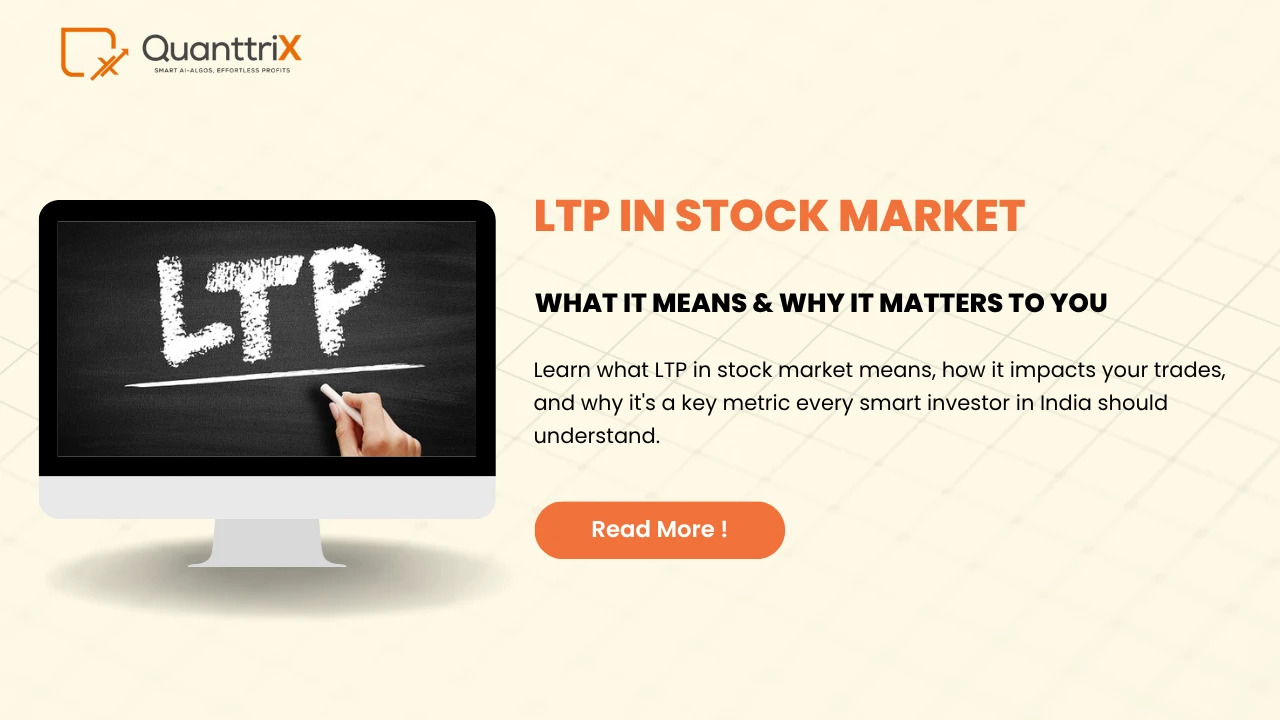LTP in Stock Market: The Last Traded Price Explained for Everyone
Introduction
Have you ever glanced at stock tickers flashing numbers on TV or your trading app and wondered, “What do these prices really mean?” If so, you’re not alone! Among the many financial abbreviations, “LTP” shows up almost everywhere in the stock market. Whether you’re just getting started, trading for fun, or aiming for financial freedom, understanding ltp meaning in stock market can feel like learning a new language.
But don’t worry—think of LTP as the “heartbeat” of a stock: the freshest signal that tells you where the action is, moment by moment. In this article, we’ll unpack “ltp full form in stock market,” break down its significance, and even see how automated trading software uses LTP to make lightning-fast decisions. Ready to decode the mystery?
Discover ltp full form in stock market, ltp meaning in stock market, and how it connects with automated trading software. A complete, engaging, and beginner-friendly guide.
LTP Full Form in Stock Market
LTP stands for Last Traded Price in the world of stocks and shares. It’s as simple as it sounds: the price at which the most recent transaction (buy or sell) took place for a particular stock.
Imagine you’re at an auction, bidding on a painting. The last amount called out after the hammer drops is the “LTP” of that sale. In the stock market, this price updates every time someone buys or sells a share.
LTP Meaning in Stock Market
So, what does LTP actually mean for investors and traders? The ltp meaning in stock market is the most recent price at which a stock was bought or sold. It’s a real-time indicator of the value that buyers and sellers agree upon at that moment.
If you log into your trading account during market hours, you’ll notice that stock prices are constantly changing. That’s LTP in action—a living price tag that never sleeps.
LTP vs. Closing Price
It’s easy to mix up LTP with the “closing price,” but they’re not always the same.
- LTP: The very last price at which a stock was traded, even if it’s just seconds before the market closes.
- Closing Price: An average of prices during the last few minutes of trading or sometimes the last LTP itself, depending on the exchange’s calculation method.
So, the LTP can change in the final seconds of a trading session, while the closing price takes a snapshot at the end.
Why Does LTP Matter for Investors?
The LTP acts like a live scoreboard at a sports game. Whether you’re a casual spectator (long-term investor) or an active player (day trader), you want to know where things stand right now.
- Immediate Value: LTP tells you the going rate before you place your trade.
- Market Sentiment: Rapid changes in LTP reflect how people feel about a stock.
- Entry and Exit: It helps you decide when to buy, sell, or wait.
For example, if you see the LTP increase steadily over a few minutes, you might sense bullish (positive) momentum.
How is LTP Calculated?
Here’s the best part: there’s no deep formula! LTP is simply the price of the last successful trade.
Let’s say Stock XYZ was traded at ₹100, then at ₹101, and finally at ₹102 in quick succession. The LTP is ₹102, until another trade happens. Every time a trade occurs, LTP updates immediately.
Influence of LTP on Market Sentiment
Think of LTP as a weather vane for the stock’s popularity.
- If LTP rises, people think the stock is worth more—maybe good news is out.
- If LTP falls, investors might be cautious or reacting to negative news.
- If LTP stays steady, the market may be waiting for new information.
Financial headlines often mention a stock’s LTP to showcase its current direction.
LTP in Different Markets
LTP isn’t limited to just one kind of market:
- Equity (Stock) Markets: LTP is used for individual stocks, mutual funds, and ETFs.
- Derivatives (Futures & Options): LTP shows the current price for contracts.
- Commodities & Forex: LTP applies to gold, oil, currency pairs, and more.
No matter the market, LTP acts as the “living price.”
Role of Automated Trading Software
Imagine trying to keep up with every LTP change manually. It sounds impossible, right? That’s where automated trading software comes in—like having a super-fast robot assistant who watches LTPs for you.
- Speed: Automated systems can react to LTP changes in milliseconds.
- Strategy: They use algorithms to buy or sell automatically if LTP hits a certain price.
- Volume: These programs can process thousands of trades simultaneously, something no human can do.
Some sophisticated investors and large institutions rely heavily on automated trading software because it responds to LTP data with precision and speed.
LTP and Day Trading
For day traders—the sprinters of the market—every tiny move in LTP could mean profit or loss.
- Intraday Opportunities: A sudden jump or dip in LTP can signal a trading opportunity.
- Stop-Loss & Target Prices: Many traders set up automated trades that trigger if the LTP crosses a certain threshold.
- Quick Reflexes Needed: Since LTP changes rapidly, day traders need to act fast—or let automated systems act for them.
LTP in Large-Cap vs. Small-Cap Stocks
Large-Cap Stocks (like Reliance, Apple, TCS):
- LTP changes happen frequently because there are many buyers and sellers.
- LTP is more stable and reflects broader market confidence.
Small-Cap Stocks:
- LTP can jump up or down sharply due to smaller trading volumes.
- A single transaction can move prices noticeably.
Understanding these dynamics can help you pick the right stock for your trading style.
LTP and Stock Volatility
Volatility means how much the price goes up or down over time.
- High Volatility: The LTP jumps around a lot—like a rollercoaster!
- Low Volatility: The LTP barely moves—think of a calm, flat lake.
Stocks with frequently changing LTP might carry more risk but also offer more chance for reward.
How to Track LTP in Real-Time?
You don’t need to camp out in front of the stock exchange! Here’s how anyone can keep an eye on LTP:
- Trading Platforms: Most online brokers display LTP in their dashboards.
- Stock Market Apps: Free apps provide real-time LTPs for Indian and global stocks.
- Financial News Channels: TV and websites show live LTP tickers.
- Automated Trading Software: For advanced users, these tools pull live LTPs and act on your behalf.
Pick the platform you’re most comfortable with and watch the market unfold in real time.
Common Misconceptions About LTP
There are a few myths floating around about “ltp meaning in stock market.” Let’s bust some of them:
- Myth: LTP is the price at which you can always buy or sell.
- Reality: The LTP is simply the last price, but your trade might happen at a slightly different rate if the market moves quickly or there’s low liquidity.
- Myth: LTP and market price are the same.
- Reality: Market price can refer to the bid/ask price, while LTP is only the most recent transaction.
- Myth: LTP doesn’t change often.
- Reality: In active markets, LTP can change many times per second!
Understanding what LTP does not mean is as important as knowing its real value.
LTP in the World of Online Trading
Online trading platforms have put real-time LTP at everyone’s fingertips. You can place trades, set alerts, or even program certain actions to happen if LTP crosses set levels.
- Accessibility: LTP is no longer just for market insiders.
- Transparency: Everyone can see the same real-time price information.
- Control: Retail investors can make informed decisions quickly.
Even if you’re just starting, LTP is your instant window into market action.
The Future: LTP & Technology
Where is LTP headed in the world of rapid tech growth?
- Big Data & AI: Advanced algorithms analyze LTP trends to make smarter predictions.
- Faster Trades: With 5G and better servers, LTP data is more instant than ever.
- Global Access: Investors across the world track the same LTP, leveling the playing field.
Imagine LTP as the “pulse” of the market—a pulse that’s getting faster and more accurate with every technical innovation.
Conclusion
Understanding “ltp meaning in stock market” and “ltp full form in stock market” bridges the gap between confusion and confidence for any investor. LTP is the quick, clear beacon of a stock’s value, letting you see exactly where the market stands each moment.
Just like a heart monitor gives you real-time updates about your health, LTP delivers the freshest insights into any stock. And with the evolution of automated trading software, tracking this vital sign has never been easier—or faster.
Whether you’re a beginner, a casual investor, or an aspiring day trader, knowing how to use LTP empowers you to make smart, timely decisions. Happy investing!
FAQs
1. What does LTP stand for in the stock market?
LTP stands for “Last Traded Price”; it’s the most recent price at which a stock was bought or sold.
2. Is the last traded price (LTP) always the price I’ll get if I trade?
Not necessarily. The LTP is only the last successful transaction’s price; your order may execute at the LTP or a slightly different price if the market moves.
3. How can I check a stock’s LTP in real time?
You can use trading platforms, financial news apps, or even automated trading software to see real-time LTP updates at home or on the go.
4. What’s the difference between LTP and the closing price?
LTP is the price of the latest trade, while the closing price is either an average or the last LTP at the end of the trading session, depending on the exchange.
5. How does automated trading software use LTP?
Automated trading systems monitor LTPs continuously and can buy or sell instantly when certain price conditions (like crossing a specific LTP) are met, maximizing speed and efficiency.



